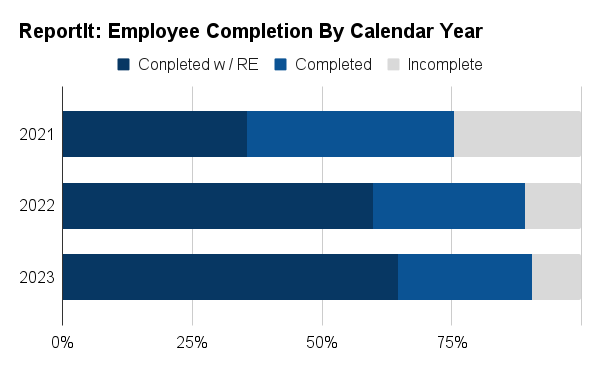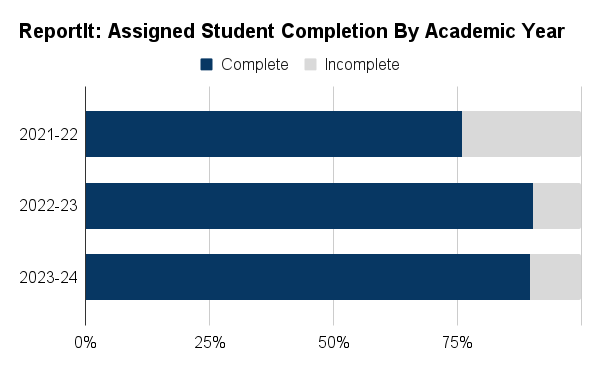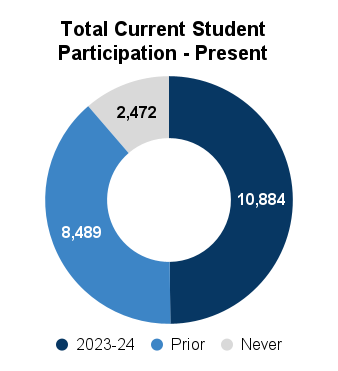Sexual Misconduct Prevention Progress Report 2024
Prepared by the Office of Equity and Access, April 2024
In our 2024 Sexual Misconduct Prevention Progress Report, we present an overview of Stony Brook University's efforts to prevent and respond to sexual misconduct. Our university is dedicated to providing a safe and inclusive environment free from all forms of discrimination, including sexual harassment and sexual violence. We remain committed to ensuring the safety and well-being of all members of our community.
Table of Contents
Section 1: Task Force Implementation and Continued Effort
Section 2: Recent Investigation Statistics
Section 3: Training and Outreach
Section 4: New Title IX Regulations Anticipated
Section 1: Task Force Implementation & Continued Effort
Jump to: Section 2 | Section 3 | Section 4
Since our last Progress Report, OEA has worked diligently to implement the recommendations outlined by Title IX and Sexual Misconduct Task Force. (“Task Force”), We could like to thank all Task Force members for their unwavering commitment to fostering a safer environment for all individuals.
Task Force Recommendations Implemented in 2023
OEA successfully implemented all of the Task Force's recommendations. The actions taken were:
- Enhanced Candidate Background Checks: Recognizing the importance of proactive measures, OEA has taken decisive steps to ensure that candidates with a history of sexual misconduct are not integrated into our community. Implementation of this initiative commenced at the conclusion of 2023.
- Increased Availability of Training, particularly In-Person Programming: OEA has a longstanding tradition of delivering in-person training since its inception, supplemented by online Title IX training available to the campus community for nearly a decade. Since our last report, OEA has conducted 38 live training sessions across Stony Brook University, the University Hospital, Southampton, and other areas and departments, with a notable surge in participation in our online programs addressing sexual misconduct.
- For Complainants, Respondents, and Witnesses: OEA has consolidated the Sexual Misconduct and Title IX web pages into a revamped Sexual Misconduct and Title IX website. The website home page is designed to offer clear and concise options to its visitors looking for options following an incident, including reporting to the university and confidential resources as well as information on how to contact law enforcement, access medical services, support a friend and guidance for employees who are required to report. The websitealso includes, per Task Force recommendation, comprehensive FAQs and pertinent information tailored for complainants, respondents, and witnesses. The previous year's close finalized an interactive website accessible via the following URL: https://www.stonybrook.edu/commcms/oea-sm-tix/resources/faqs.php.
- Q&A with OEA for Academic Departments: OEA held FAQ Sessions with 6 academic departments across the University in 2023 and we are working with the Provost area to get to more academic departments in 2024. We have also expanded the program to non-academic departments and continue to hold sessions upon request. The purpose of these sessions is to foster open dialogueThis novel program allows faculty to pose queries within a non-training, non-investigative, small-group setting. As previously noted, OEA overall has has provided 38 live and in-person training sessions, accommodating departmental requests.
- Information for Parties: OEA remains steadfast in providing parties involved in cases with comprehensive information regarding the investigative process, which transitioned to an online format during the pandemic. A dedicated website "Information for Parties in Sexual Misconduct Cases" has been established to facilitate an interactive review of our current processes.
Additional OEA Efforts
- Website Safe Exit: Recognizing the sensitive nature of sexual misconduct, OEA acknowledges the apprehensions victims individuals may have in seeking assistance. As a proactive measure, OEA has implemented a quick exit feature across all relevant websites, providing information on reporting and resources related to sexual misconduct, including sexual violence. This feature enables reporters or victims to exit the site swiftly should they feel unsafe simply by selecting the "exit site" button.
- Improving On-Line Learning: OEA has updated its training resources and made available all student training related to sexual misconduct on Brightspace, a learning management system (LMS). This has enabled users to complete their annual training at their convenience in one sitting or multiple sittings. In 2022 OEA successfully launched online programming for Hospital Employees in Health Stream, the Hospital LMS and is working to make programming available for the remainder of Stony Brook UniversityUniveristy employees in 2024. has also taken significant steps to shift most University and University Hospital employees to an LMS and is committed to continuing this effort for the remainder of the year.
- Increased Social Media Presence: OEA increased its outreach efforts by working with Marketing and Communications to develop some videos to be shared on various social media platforms. These videos are designed to give students information on reporting and what they can expect following a complaint. Examples of videos posted can be found below:
| Video 1 - How Can I Prevent Sexual Violence? | Video 2: How Can I Report An Incident? | Video 3: I Reported & Nothing Happened. |
|
Video 1 Description: Renaire Frierson, Assistant Title IX Coordinator, sits on a bench on the academic mall on a sunny day. |
Video 2 Description: A screen recording demontrates how a user going to the Sexual Misconduct Incident Report Form from the OEA website and scrolling through the various data entry points. | Video 3 Description: Renaire Frierson, Assistant Title IX Coordinator, sits on a bench on the academic mall on a sunny day. |
OEA regularly reviews and updates its Sexual Misconduct and Reporting Policy as required by applicable law and assesses to the Task Force recommendations, the OEA Title IX office haswill regularly review and update its "Sexual Misconduct and Reporting Policy" as required by applicable law and assess whether additional updates are required to meet the needs of the SBU community. This process in ongoing and we expect a revision of the policy in late Spring 2024.
Due to the success and positive impact of the Sexual Misconduct and Title IX Task Force, and with changes to Title IX on the federal level expected this year (see Section 4), OEA will be reassembling the Task Force later this year.
Section 2: Recent Investigation Statistics
Jump to: Section 1 | Section 3 | Section 4
As per the federal Clery Act and NY State Education Law 129b, the University is obligated to gather anonymous information related to reported cases of sexual misconduct. The Clery Act aims to inform the campus community about the occurrence of certain crimes (including some that fall under Title IX) that happen on or near the campus. All colleges and universities that provide federal financial aid must maintain and disclose statistical information on the listed crimes that occur within a specific geographic area of their respective campuses in an Annual Security Report published. Law 129(b) requires the University to report data on alleged sexual misconduct incidents that impact students to the New York State Education Department (NYSED).
OEA (Office of Equity and Access) is responsible for fulfilling its obligations under Clery and 129-b. In addition, OEA maintains records of all reported allegations of discrimination, including those based on sexual misconduct and violence, regardless of whether the accused or the reporting individual is a student, employee, or has some other status in our campus community.
We provide various ways to report sexual misconduct to ensure all campus community members can report an incident, including via the ReportIt website. OEA will thoroughly investigate all allegations falling under its jurisdiction. The first chart below provides data on the number of allegations received in the last three years. To ensure easy access to report allegations of sexual misconduct around the clock, OEA created the ReportIt website.
The numbers of reports received through this website are shown in the second chart.
Reported incidents involving sexual misconduct for January 2020 to December 2022
Table 1 - online submissions compared to total incidents reported.*
| Year | Website Submittion | Total incidents Reported |
|---|---|---|
| 2021 | 211 | 211 |
| 2022 | 165 | 177 |
| 2023 | 182 | 263 |
*Incidents could be reported to OEA online, by email or phone, in person, on a paper form, or through partner offices. Many of these options, including online, allow for an anonymous report. Any allegation can be reported directly to OEA, the Title IX Coordinator, deputy coordinators, or responsible employees and is taken seriously. Once the OEA is aware of this, it begins its process of addressing the report. This can take many forms, from providing resources to a formal investigation.
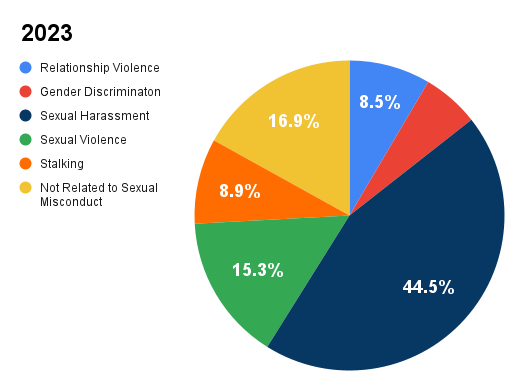 |
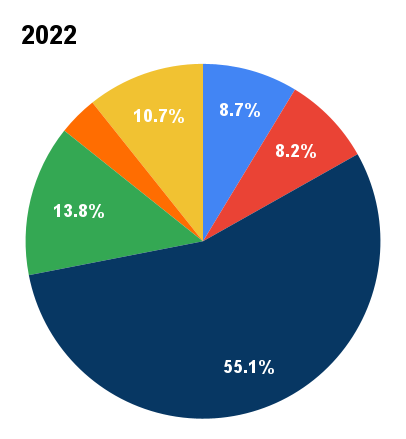 |
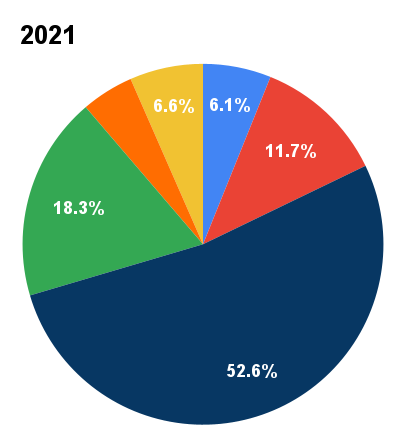 |
Table 2 - Allegations*
|
Anyone can report allegations related to University Policies. OEA has jurisdiction
over policies related to discrimination which includes sexual misconduct.
* Allegations have been combined to align with commonly recognized categories. For
common categories and their respective definitions, please see the University Policy Manual, Equal Opportunity/Affirmative Action Policy, and Sexual Misconduct & Reporting Policy.
**Some reports to OEA or Title IX do not involve sexual misconduct. The numbers in
this table include all reports regardless of whether a subsequent review determined
there was no sexual misconduct as outlined by university policies.
Section 3: Training and Outreach
Jump to: Section 1 | Section 2 | Section 4
The Office of Equity and Access remains focused on addressing reported complaints while using training and outreach to educate the campus community on our policies and procedures, as well as to foster a campus community that is ever more equitable and accessible. We strive to ensure that everyone knows what to report and how to report and that Stony Brook University encourages students, faculty, and staff to report any incident they are aware of or experience.
Our most visible training program is our online series under the umbrella of “ReportIt: Ending Sexual Misconduct,” which includes the following versions:
- Onboarding Employees
- Onboarding Responsible Employee
- Annual Review for Employees
- Annual Review for Responsible Employees
- Onboarding Students
- Annual Review for Students
- Annual Review for Mandated Reporters
Under New York state law, all employees must be trained annually on Stony Brook University sexual harassment prohibitions and procedures. Employees are assigned the onboarding or annual review version and are prompted to participate as responsible employees as appropriate.
 |
|
New York state law also requires onboarding students, student-athletes, and student-leaders to be provided annually with training in sexual misconduct policy and procedure. These students are assigned the appropriate version of ReportIt as required.
Resident Assistants (RA) and other student workers who work directly with students may be assigned the Mandated Reporter program as appropriate.
In addition, OEA provides in-person programming to various employee and student departments or organizations as requested and appropriate.
|
|
|
As part of our commitment to the recommendations made by the Title IX Task Force,
we prioritize providing training, outreach, and prevention. To achieve this, we increased
the availability of training in different formats to be more available for the campus
community. We will continue to ensure the campus community knows the on-demand, in-person
training programs available for departments and student groups. Additionally, it will
ensure that open enrollment sessions will be offered to faculty and graduate students.
We have also completed online programs that will provide information and resources
to faculty-leading students abroad.
.
Section 4: New Title IX Regulations Anticipated
Jump to: Section 1 | Section 2 | Section 3
Summary of Title IX Final Rule Status
The Department of Education (ED) finalized its Title IX rule in February 2024 and
submitted it to the White House Office of Information and Regulatory Affairs (OIRA)
for review. This is the last step before the public can see the details of the rule.
Here's a breakdown of the key points:
Current Status: OIRA is reviewing the final rule. This typically takes 30-60 days
but can take up to 90 days.
Possible Release Date: Uncertain. The Office of Management and Budget (OMB), the
parent agency of OIRA, requires no more than 90 days to finalize regulatory changes.
This deadllnie would expire on May 6, 2024. Details of the Rule: Not publicly available
yet.
Background
The proposed rule, introduced in June 2022, will replace the 2020 final rule and
expand protections against sex-based discrimination.
ED received over 240,000 comments during the public comment period, causing a delay
in finalizing the rule.
Moving Forward
The public cannot request to view the rule details while it is under OIRA review. We cannot be sure how similar or varied the final rule will be from the rule proposed in 2022. However, you can review a summary of the major provisions in the proposed rule by visiting the US Department of Education's website.
As we did in the summer of 2020, OEA will ensure that all steps to comply with all federal requirements are implemented in a way that preserves Stony Brook University’s commitment to a safe and accessible facilities and programs where discrimination, including any form of sexual misconduct is not tolerated.

